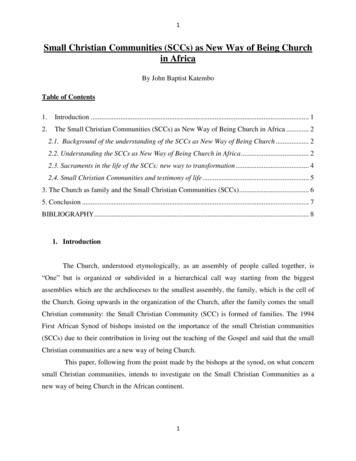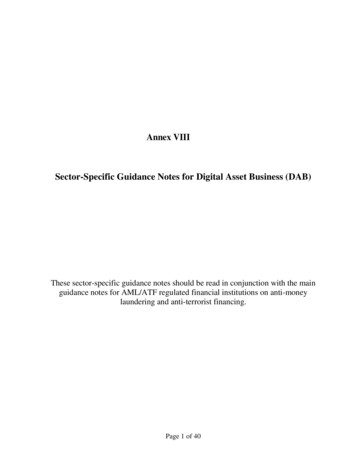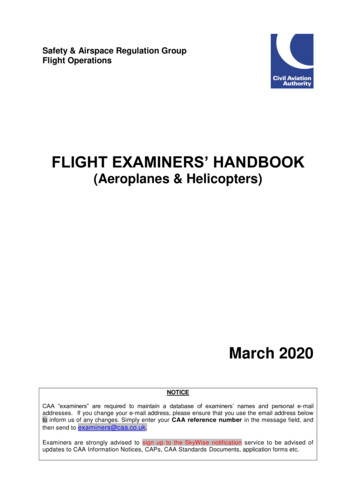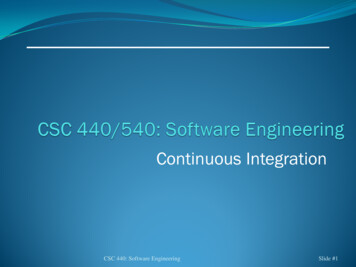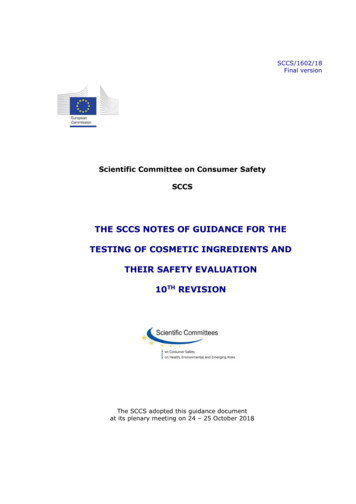
Transcription
SCCS/1602/18Final versionScientific Committee on Consumer SafetySCCSTHE SCCS NOTES OF GUIDANCE FOR THETESTING OF COSMETIC INGREDIENTS ANDTHEIR SAFETY EVALUATION10TH REVISIONThe SCCS adopted this guidance documentat its plenary meeting on 24 – 25 October 2018
TABLE OF CONTENTSACKNOWLEDGMENTS. 1About the Scientific Committees . 2SCCS . 2Scientific Committee members . 2Main changes in 10th REVISION of the SCCS Notes of Guidance (NoG) . 41.INTRODUCTION . 52.THE SCIENTIFIC COMMITTEE ON CONSUMER SAFETY, SCCS . 63.2-1HISTORICAL BACKGROUND . 62-2MANDATE . 62-3RULES OF PROCEDURE . 62-4OPINIONS . 62-4.1The "Notes of Guidance" . 62-4.2SCCS Cosmetic ingredient dossiers . 72-4.3Specific issues taken up in NoG . 7SAFETY EVALUATION OF COSMETIC INGREDIENTS . 83-1SAFETY EVALUATION OF COSMETIC INGREDIENTS AS APPLIED BY THE SCCS . 83-2CHEMICAL AND PHYSICAL SPECIFICATIONS OF COSMETIC INGREDIENTS . 113-2.1Chemical identity . 113-2.2Physical form. 123-2.3Molecular weight . 123-2.4Identification and purity of the chemical and isomer composition . 123-2.5Characterisation of the impurities or accompanying contaminants . 133-2.6Relevant physicochemical specifications . 133-2.7Solubility . 133-2.8Partition coefficient (Log Pow) . 143-2.9Homogeneity and stability . 143-3EXPOSURE ASSESSMENT . 143-3.1Functions and uses of cosmetic ingredients . 143-3.2Identification of relevant exposure scenarios . 143-3.3Identification of the targeted dose for safety evaluation . 153-3.4External exposure . 153-3.4.1Exposure models and tiered approach . 153-3.4.1.1Dermal exposure models . 163-3.4.1.2Oral exposure models . 173-3.4.1.3Inhalation exposure models . 173-3.4.2Model parameters . 203-3.4.2.1Daily use amounts and retention factors . 203-3.4.2.2Concentrations . 243-3.4.2.3Parameters specific for inhalation exposure . 24ii
3-3.4.33-3.5Aggregate exposure . 24Internal Exposure . 253-3.5.1Toxicokinetics (ADME) . 253-3.5.1.1Dermal/percutaneous absorption . 263.3.5.1.2absorption after ingestion . 293.3.5.1.3Inhalation . 293-3.5.23-4Differences in metabolism for different routes . 303-3.5.2.1Systemic metabolism . 303-3.5.2.2Dermal metabolism . 313-3.5.2.3Lung metabolism . 323.3.5.3PBPK modelling . 323-3.5.4Calculation of the systemic exposure dose (SED) . 343-3.5.5Aggregation of the systemic dose . 36RELEVANT TOXICOLOGICAL STUDIES ON COSMETIC INGREDIENTS . 363-4.1Introduction . 363-4.2In silico Assessment of Toxicological Hazard . 363-4.3Adverse Outcome Pathway (AOP) . 393-4.4Acute toxicity . 393-4.4.1Acute oral toxicity . 393-4.4.2Acute dermal toxicity . 403-4.4.3Acute inhalation toxicity . 403-4.5Skin corrosion and skin irritation . 403-4.5.1Skin corrosion. 403-4.5.2skin irritation . 413-4.6Serious eye damage and eye irritation . 423-4.7Skin sensitisation . 443-4.8Repeated dose toxicity . 473-4.9Reproductive toxicity . 483-4.10Mutagenicity / Genotoxicity . 493-4.11Carcinogenicity . 543-4.12Photo-induced toxicity . 563-4.12.1Photo-irritation and photo-sensitisation . 563-4.12.2Photo-mutagenicity / Photo-genotoxicity. 573-4.13human data in hazard assessment . 583-4.14Human Biomonitoring . 593-53-4.14.1Definition . 593-4.14.2Fields of application . 593-4.14.3Other considerations . 60GENERAL PRINCIPLES FOR THE CALCULATION OF THE MARGIN OF SAFETY AND THRESHOLD OFTOXICOLOGICAL CONCERN . 603-5.1Calculation of the Margin of Safety of a cosmetic ingredient . 603-5.1.1The POD value . 613-5.1.2The PODsys value . 62iii
3-5.1.33-5.2MoS Analysis . 63The threshold of toxicological concern (TTC) . 653-5.2.1General concept of TTC in risk assessment . 653-5.2.2TTC approach for human health risk assessment of chemical substances and cosmeticsubstances 653-6SPECIAL CONSIDERATION FOR CERTAIN COSMETIC INGREDIENTS . 673-6.1Multi-constituent natural ingredients . 673-6.2Identification of mineral, animal, botanical and biotechnological ingredients in a cosmetic product. 673-6.3Animal-derived cosmetic substances . 693-6.4Sun protection substances . 693-6.5Endocrine active substances (EAS) . 703-6.5.1Definitions . 703-6.5.2Stepwise approach for cosmetics and their ingredients . 713-6.6CMR Substances. 743-6.7Nanomaterials . 743-6.7.1Definition of nanomaterial . 743-6.7.2Potential safety issues of nanomaterials . 743-6.7.3Required information for nanomaterials . 763-6.83-6.8.1MoS calculations for hair dye formulations . 773-6.8.2Assessment of oxidative hair dye substances and reaction products. 773-6.94.Cosmetic ingredients for baby and children products . 783-6.9.1Definitions . 783-6.9.2Age-related susceptibilities/sensitivities. 783-6.103-7Hair dyes and hair dye components . 76Substances with very low dermal absorption . 81FURTHER REMARKS FOR APPLICANTS . 81REFERENCE LIST . 83APPENDIX 1: INFORMATION ON REGULATION (EC) No 1223/2009 AND THE SCCS . 113APPENDIX 2: LISTS OF SUBSTANCES . 119APPENDIX 3: STANDARD FORMAT OF THE OPINIONS . 122APPENDIX 4: ANIMAL TESTING: INTERFACE BETWEEN REACH AND COSMETICS REGULATIONS. 132APPENDIX 5: CMR GUIDANCE ON SAFE USE OF CMR SUBSTANCES IN COSMETIC PRODUCTS . 133APPENDIX 6: REQUIREMENTS FOR THE CERTIFICATE OF ANALYSIS FOR A COSMETIC INGREDIENT . 137APPENDIX 7: DETAILED EXPOSURE DATA FOR COSMETIC PRODUCTS . 138APPENDIX 8: KEY CHARACTERISTICS OF CARCINOGENS . 140ABBREVIATIONS AND GLOSSARY OF TERMS . 141iv
Nam et ipsa scientia potestas estFor knowledge itself is powerFrancis Bacon (1561 - 1626) EssaysThe “Notes of Guidance for the Testing of Cosmetic Ingredients and Their SafetyEvaluation by the SCCS” is a document compiled by the members of the ScientificCommittee on Consumer Safety (SCCS, replacing the former SCCP, SCCNFP and SCC).The document contains relevant information on the different aspects of testing andsafety evaluation of cosmetic substances in Europe. The emphasis of this guidance is oncosmetic ingredients, although some guidance is also indirectly given for the safetyassessment of finished products. It is designed to provide guidance to public authoritiesand to the cosmetic industry in order to improve harmonised compliance with thecurrent cosmetic EU legislation. An important development in recent years was the fullimplementation of the cosmetic legislation, Regulation (EC) No 1223/2009, meaningthat the animal testing and marketing bans fully apply from 2013 onwards: no in vivotesting of finished products after March 2004; no in vivo testing for local toxicity afterMarch 2009 and no in vivo testing for repeated dose toxicity (including sensitisation)toxicokinetics and developmental toxicity from March 2013 onwards for the purpose ofcosmetics. For this reason, the SCCS has closely followed the progress made with regardto the development and validation of alternative methods, with emphasis onreplacement methodology.The "Notes of Guidance" are regularly revised and updated in order to incorporate theprogress of scientific knowledge in general, and the experience gained, in particular inthe field of testing and safety evaluation of cosmetic ingredients.The previous revision of the Notes of Guidance took place in 2015 (SCCS/1564/15).Since then, several new addenda, opinions and memoranda of importance to the contentof this guidance document have been adopted and they form the basis of this newrevision. Focus is on exposure and the application of alternative methods, morespecifically on non-animal methods.As was also the case in previous revisions, individual opinions are not provided in detailbut are briefly summarised and clearly referred to.The "Notes of Guidance" have been compiled to provide assistance in the complexprocess of the testing and safety evaluation of cosmetic ingredients in the EU.Input of scientists from the scientific committee SCHEER and Cosmetics Europe isgratefully acknowledged.The Chairpersonv
ACKNOWLEDGMENTSSCCS members listed below are acknowledged for their valuable contribution to thefinalisation of this guidance document.SCCS membersDr U. BernauerDr L. BodinProf. Q. ChaudhryProf. P.J. CoenraadsProf. M. DusinskaDr J. EzendamDr E. GaffetProf. C. L. GalliDr B. GranumProf. E. PanteriProf. V. RogiersDr Ch. RousselleDr M. StepnikProf. T. VanhaeckeDr S. Wijnhoven(SCCS Chair)(SCCS Vice-Chair)(SCCS Vice-Chair and rapporteur)SCCS external expertsDr A. KoutsodimouDr A. SimonnardProf. W. UterDr N. von GoetzAll Declarations of Working Group members are available on the following webpage:http://ec.europa.eu/health/scientific committees/experts/declarations/sccs en.htmKeywords: SCCS, SCCS Notes of Guidance for the Testing of Cosmetic Ingredients and theirSafety Evaluation, 10th revision, SCCS/1602/18Opinion to be cited as: SCCS (Scientific Committee on Consumer Safety), SCCS Notes ofGuidance for the Testing of Cosmetic Ingredients and their Safety Evaluation 10th revision,24-25 October 2018, SCCS/1602/181
ABOUT THE SCIENTIFIC COMMITTEESTwo independent non-food Scientific Committees provide the Commission with the scientificadvice it needs when preparing policy and proposals relating to consumer safety, public healthand the environment. The Committees also draw the Commission's attention to the new oremerging problems which may pose an actual or potential threat.These Committees are: the Scientific Committee on Consumer Safety (SCCS) and theScientific Committee on Health, Environmental and Emerging Risks (SCHEER) and they aremade up of scientists appointed in their personal capacity.In addition, the Commission relies upon the work of the European Food Safety Authority(EFSA), the European Medicines Agency (EMA), the European Centre for Disease preventionand Control (ECDC) and the European Chemicals Agency (ECHA).SCCSThe Committee shall provide Opinions on questions concerning all types of health and safetyrisks (notably chemical, biological, mechanical and other physical risks) of non-food consumerproducts (for example: cosmetic products and their ingredients, toys, textiles, clothing,personal care and household products such as detergents, etc.) and services (for example:tattooing, artificial sun tanning, etc.).SCIENTIFIC COMMITTEE MEMBERSBernauer Ulrike, Bodin Laurent, Chaudhry Qasim, Coenraads Pieter-Jan, Dusinska Maria,Ezendam Janine, Gaffet Eric, Galli Corrado Lodovico, Granum Berit, Panteri Eirini, RogiersVera, Rousselle Christophe, Stępnik Maciej, Vanhaecke Tamara, Wijnhoven SusanContactEuropean CommissionHealth and Food SafetyDirectorate C: Public Health, Country Knowledge, Crisis ManagementUnit C2 – Country Knowledge and Scientific CommitteesL-2920 LuxembourgSANTE-C2-SCCS@ec.europa.eu European Union, 2018ISSN 1831-4767ISBN NThe Opinions of the Scientific Committees present the views of the independent scientistswho are members of the committees. They do not necessarily reflect the views of theEuropean Commission. The Opinions are published by the European Commission in theiroriginal language only.http://ec.europa.eu/health/scientific committees/consumer safety/index en.htm2
Applicants are invited to visit the SCCS website:https://ec.europa.eu/health/scientific committees/consumer safety/opinions enwhere Applicants will find a checklistfor submitting a safety dossier of a cosmeticingredient.Applicants are invited to visit the following websitefor further legislative smetics/legislation en3
MAIN CHANGES IN 10TH REVISION OF THE SCCS NOTES OF GUIDANCE (NOG)Structural changes The general structure of the Notes of Guidance has been changed to give priorityto non-animal methods, followed by older in vivo strategies. Information on Regulation 1223/2009/EC and guidance related to finishedcosmetic products (Product Information File, PIF) is now included in the Annexes. A (revised) checklist for submitting a safety dossier to the SCCS has been added. An update of the data needed for safety evaluation has been included andinformation for re-submitting is also given in case of a negative opinion. References and abbreviations lists have been updated. The exposure chapter has been updated with subdivisions for external andinternal exposure – tiered approach and aggregate exposure are discussed.Changes in content An update on non-animal toxicological studies for cosmetic ingredients has beenincluded. Weight of Evidence (WoE) and use of a 'toolbox' (genotoxicity/mutagenicity) arediscussed. An update of criteria for multi-constituent natural ingredients and chemicalidentity has been included. The Threshold of Toxicological Concern concept – TTC - remains the same, i.e.new suggested values in publication have not yet been evaluated. A literature overview of consumer exposure data has been added in Appendix 7.4
1.INTRODUCTIONSince July 2013, Regulation (EC) No 1223/2009 applies for cosmetic products. Their safetyin-use is, as was also the case for Directive 76/768/EEC, established by controlling the safetyof the ingredients.For those ingredients for which some concern exists with respect to human health (e.g.colourants, preservatives, UV-filters, hair dyes), safety evaluation is done at the Commissionlevel by the Scientific Committee on Consumer Safety (SCCS). These substances areaddressed in the Annexes of Regulation (EC) No 1223/2009.For the safety evaluation of cosmetic ingredients, all available scientific data are considered,taking into account the testing and marketing bans in force under Regulation (EC) No1223/2009. This includes the physical and chemical properties of the compounds underinvestigation, in silico data such as results obtained from (Q)SAR {(Quantitative) StructureActivity Relationship} modelling, chemical categories, grouping, read-across, PhysiologicallyBased PharmacoKinetics (PBPK) / ToxicoKinetics (PBTK) modelling, in vitro and ex vivoexperimental results and data obtained from animal studies (in vivo) that have been carriedout for the purpose of cosmetics before the testing and marketing bans.The animal testing ban on finished cosmetic products applies since 11 September 2004; thetesting ban on ingredients or combination of ingredients applies since 11 March 2009. Themarketing ban applies since 11 March 2009 for all human health effects with the exceptionof repeated-dose toxicity, reproductive toxicity, and toxicokinetics. For these specific healtheffects, the marketing ban applies since 11 March 2013, irrespective of the availability ofalternative non-animal methods.In addition, clinical data, epidemiological studies, information derived from accidents, datafrom Post-Marketing Surveillance (PMS) or other human data are also taken intoconsideration.In the present update, the state-of-the-art with respect to the validated methods of the 3Rs(Refinement, Reduction and Replacement) strategy of Russell et al. (1959), is incorporatedwith emphasis on New Approach Methodologies (NAMs). In view of the testing and marketingbans in the cosmetic regulation, the SCCS gives special attention to those alternative methodsthat are suitable for the safety testing of cosmetic substances.Although the "Notes of Guidance" are concerned with the testing and safety evaluation of thecosmetic substances listed in the Annexes of Regulation (EC) No 1223/2009 and those forwhich safety concerns have been expressed, they could be also of interest for all substancesintended to be incorporated in a cosmetic product. Even though the "Notes of Guidance" havenot been written for the latter purpose, they can indeed be of practical use in making aProduct Information File (PIF) for a finished cosmetic product as currently required byRegulation (EC) No 1223/2009.The “Notes of Guidance” should not be seen as a prescriptive procedure, but rather as anapproach that may need to be adapted on a case-by-case basis when evaluating the safetyof the Annex substances. However, when major deviations from standardisedprotocols/procedures in the safety evaluation process have been adopted, it is essential thatApplicants provide scientific justification.The "Notes of Guidance" will be revised as scientifically required on the basis of scientificadvances in toxicology and validated alternative methods or legislative changes.5
2.THE SCIENTIFIC COMMITTEE ON CONSUMER SAFETY, SCCS2-1 HISTORICAL BACKGROUNDThe SCCS with its current mandate and composition was established in 2016 and will beactive until March 2021.For more information, see Appendix 1.2-2 MANDATEThe SCCS is an advisory body that provides the Commission with scientific advice and safetyevaluations for Annex substances and compounds for which some concern for human healthexists. Its consultation for this task is compulsory.For more information, see Appendix 1.2-3 RULES OF PROCEDUREThe SCCS works with 3 working groups, dealing with: cosmetic ingredients methodology nanomaterials.Safety evaluations and advice are taken up in opinions, which are adopted during a plenarymeeting (or by written procedure). A commenting period is foreseen for draft opinions beforethey are finalised and published.For more information, see Appendix 1.2-4 OPINIONSOpinions are published on the SCCS website:https://ec.europa.eu/health/scientific committees/consumer safety/opinions en.For more information, see Appendix 1.2-4.1THE "NOTES OF GUIDANCE"One of the responsibilities of the SCCS is to recommend a set of guidelines to be taken intoconsideration by the cosmetic and raw material industry in developing adequate studies tobe used in the safety evaluation of cosmetic substances.This is done through the ‘Notes of Guidance for the Testing of Cosmetic Ingredients and TheirSafety Evaluation’ (NoG) that are regularly revised and updated in order to incorporate newknowledge and scientific and regulatory advances. Therefore, dossiers submitted to the SCCSshould be in accordance with the latest published version of the NoG. The 9th RevisionSCCS/1564/15 of 25 April 2016 is now replaced by this 10th Revision SCCS/1602/18.As cosmetic ingredients are chemical substances, the NoG include the toxicological testprocedures reported in Commission Regulation (EC) No 440/2008. The latter describes thebasic toxicity testing procedures needed to evaluate different human health-relatedtoxicological endpoints and are internationally accepted as being the result of long-termscientific agreement. Whereas the testing procedures for chemical subst
The document contains relevant information on the different aspects of testing and safety evaluation of cosmetic substances in Europe. The emphasis of this guidance is on cosmetic ingredients, although some guidance is also indirectly given for the safety assessment of finished product s. It is designed to provide guidance to public authorities


